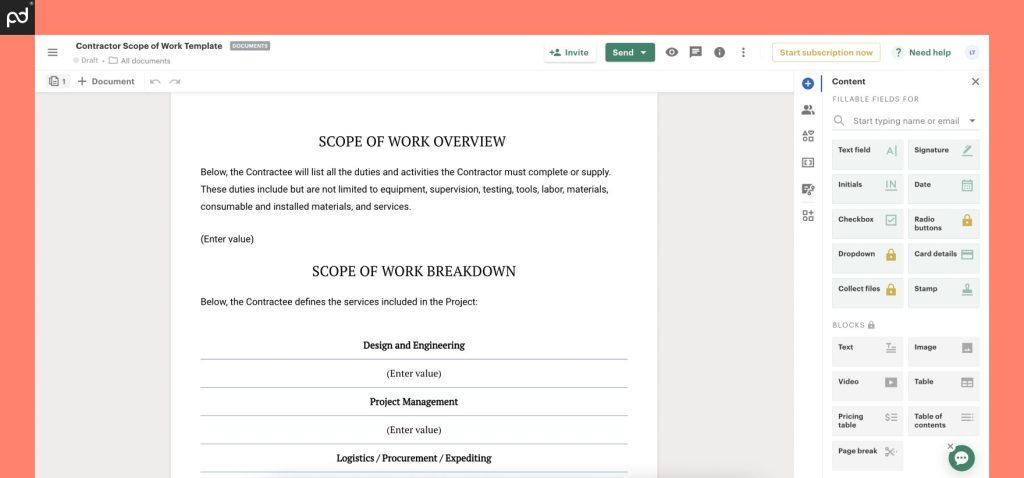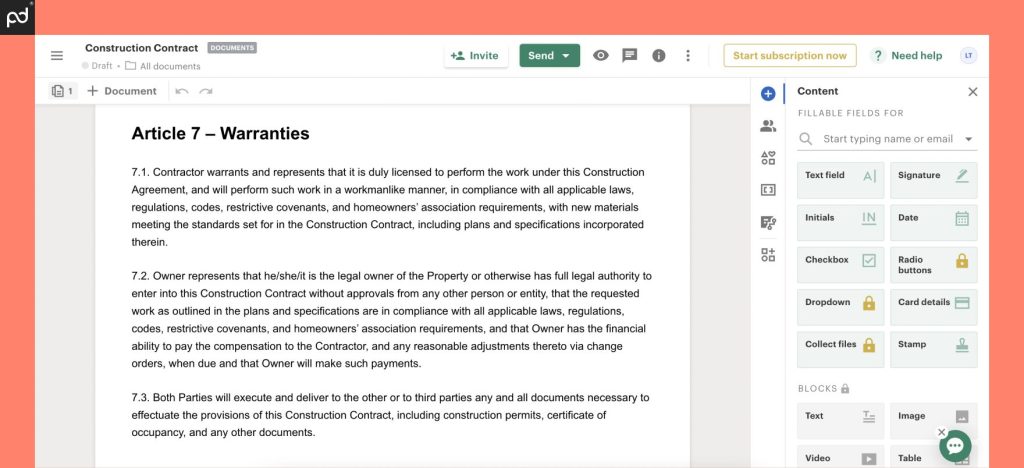Legally binding construction contracts have several sections containing provisions and clauses. Each clause deals with a specific obligation, right, privilege, deadline, or requirement.
No matter your experience in the construction industry, you still need help understanding contract clauses. Some are common and generic; others are ultra-specific for unique scenarios.
In this article, we’ll highlight all the construction contract clauses you may need for collaboration with commercial clients and government agencies.
Key takeaways
- A contract clause refers to a standard provision that encapsulates a part of the agreement in a construction project.
- Always provide detailed information in each contract clause so there is no room for loopholes or ambiguity.
- Before adding a clause to your construction contract, always seek the advice of your lawyer.
1. Scope of work
In construction, the scope of work defines everything the project must cover, starting from the needed equipment to unit prices of materials and subcontractors (subs).
To avoid confusion and disagreements, the scope of work also mentions relevant plans, specifications, or other design drawings.

2. Executive summary
This part of the contract clause, also known as an abstract, provides a brief synopsis of the contract’s main points and provisions.
It summarizes the key points of the contract so that both parties may quickly refer to it without reading the whole thing.
3. Duration
The project duration is an essential clause for proper project management. It outlines the exact project start date as well as the expected completion date.
In construction management, the duration clause sets deadlines for individual tasks and the overall project timetable. This clause is essential for finishing the project on schedule and within budget.
4. Dispute resolution
If a disagreement arises during the construction project, the parties must follow established contract dispute resolution procedures.
The dispute resolution clause should outline the rules for submitting claims (including notice provisions) as well as the deadline for starting the process.
It also specifies whether mediation is mandatory and what happens if the dispute remains unresolved: arbitration, mediation, or litigation.
5. Variation
In most construction projects, the original scope is bound to change. So, you should include a variation clause in your contract terms to handle these changes.
Variation clauses save you time and money and keep the project moving according to plan when change orders come in.
6. Termination or suspension
The termination clause outlines the parties’ rights and responsibilities and the conditions for terminating or suspending the contract.
These clauses should also include rules about notice of default and the option to cure.
As part of the termination clause, the contractor should agree with the owner on how to handle compensations and disbursements in case of termination or suspension.
7. Force majeure
A “force majeure” event, which must be specified in the contract, usually justifies a party’s failure to execute under specific provisions.
This provision, also known as the “Act of God” clause, absolves both parties from responsibility if so-called acts of God prevent them from fulfilling their obligations under the contract.
For instance, if a natural catastrophe or a government decree hinders or delays the project’s completion, the force majeure clause will outline the next steps in terms of compensation and extension.
8. Delay and disruption damages
Most projects in the construction business take longer than expected due to the unpredictable nature of construction jobs.
So, you need a clause that covers delays and disruption resulting from incompetence or misfortune.
For delays and disruptions caused by human action — say the contractor stops work for two weeks because one of their workers is sick — the delay and disruption clause will mention what they have to pay in damages.
Delay clauses are common in time-sensitive projects, especially under an incentive construction contract, where the reward depends on the speed of delivery.
9. Insurance
This provision should detail the necessary insurance coverage, including property, workers’ compensation, the policy’s coverage amount, policyholders, and general liability.
The insurance clause reassures builders and other laborers that they are covered in case of accidents or mishaps on the project site.
10. Change orders
The change orders (“changes in the work”) clause should spell out when one party has to submit their modification request and what kinds of changes are acceptable and what aren’t.
A common example of this occurrence is when an owner wants a wall moved, or a window installed in a wall where one wasn’t planned.
As with the variation clause, the client must notify the contractor of their desired changes alongside having any legal paperwork taken care of (such as required permits) before any modifications are made.
11. Payment terms
The payment terms clause details the amount to be paid, when it will be paid, the first and final payment, and any other issues related to payments.
This provision also details the conditions under which the owner can withhold or delay payments to the general contractor, usually due to defective or unacceptable work.
Subcontracts also include “pay-if-paid” or “pay-when-paid” terms. This means that subcontractors have to rely on the main contractor getting paid.
12. Choice of law
This clause specifies the laws of a particular county or state will apply to the contract’s interpretation and execution. Usually, this is the jurisdiction in which the project is situated or where the bulk of the construction takes place.
Before starting a project in Florida or New York, for instance, it’s a good idea to research state regulations to see how they may affect the contract’s contents and the project itself.
13. No lien
This provision prevents the contractor from enforcing a lien — a legal claim on any specific client property or assets — when resolving problems with the contract price in the event of a disagreement.
Basically, the contractor cannot seal off the client’s home if they are unable to pay the contractor the full price of the contract.
Under the no-lien clause, the settlement would focus on resolving the dispute according to the contract’s provisions with no damages.
14. Stop-work order / stop-payment
The stop-work order clause gives a contractor the power to stop work if the homeowner or customer does not meet financial commitments.
This stipulation also has a flip side: the stop-payment clause, which gives property owners the authority to withhold payments from underperforming contractors until they meet contractually agreed-upon commitments.
15. Inspection
The inspection clause outlines the timelines and criteria for evaluating the site in a construction contract.
This gives the inspector, like an external professional supervisor or the owner, access to the physical site to see how the project is progressing.
The inspection clause also allows the inspector to review all necessary project documents, such as report sheets, payment receipts, plans, and drawings.
16. Claims
A “claim” in a construction contract is a formal request for more resources or time to complete the project. The customer or the contractor could ask for extra time or more money.
This clause specifies how each party should file a claim as well as the deadline for filing one. As stated in the contract, claims must be in writing and sent via a certified medium to establish a paper trail.
17. Disposal of materials
The disposal of materials clause specifies who is responsible for cleaning up the site at the end of the construction work.
This section emphasizes compliance with environmental safety rules, especially when dealing with hazardous materials.

18. Confidentiality
When two parties enter into a contract, this cause lays out the ground rules for how they will handle sensitive information, trade secrets, and intellectual information.
This clause stipulates that the parties must not reveal, in any way, the confidential information to any third party without the other party’s prior written approval.
For instance, the contractor cannot reveal the identity of a client whom they helped build a secret survivalist bunker in the property’s basement.
19. Intellectual property
The intellectual property (IP) clause in a contract specifies who owns what and how it may be used in connection to any intellectual property developed while the contract is in effect.
Any work that originates from someone’s mind, whether an idea, design, trade secret, copyright, or trademark, is considered intellectual property.
Let’s say that, during the design phase, the architect comes up with a proprietary idea. The clause will determine if the owner buys out the IP or if the architect will retain ownership.
20. Waiver of liability
A waiver of liability or release of liability clause means that one party agrees not to hold another party responsible for damages or injuries. After signing the waivers, the participant can no longer sue for damages.
Contractors can use waiver of liability clauses to absolve themselves from responsibility for site mishaps, accidents, or even deaths during construction.
21. Liquidated damages
Liquidated damages estimate the loss that will occur and how much you’ll have to pay if the task is not finished on time. The construction contract should contain an acceptable, fair-market rate for liquidated damages.
22. Warranties
The warranty clause details the assurances and warranties that apply to the materials, equipment, and labor involved in the project.
It also includes the warranties of the material suppliers and the owner’s right to assign such guarantees.
This is especially important in construction projects involving costly specialized equipment.

23. Indemnification
The indemnity agreement presents the parties’ respective roles in acquiring project-specific insurance and indemnifying one another.
Under an indemnity clause, one party agrees to pay the other party’s losses if there is damage to property, death, physical harm, violation of intellectual property rights, or breach of contract.
24. Miscellaneous provisions
When specific terms in a contract fail to address a particular matter, the contract will include a clause for miscellaneous provisions.
For small construction projects, this section contains trial waivers, final agreements, notices, governing laws, etc.
However, for massive construction projects, the miscellaneous provisions should include the minutest details, including currency exchange rates and legal fees.
25. Enumeration of documents
The enumeration of documents clause specifies which documents have been appended to the agreement.
The usual documents are the contract sum, timelines, SOPs, safety instructions, permits, licenses, etc.
What if a contract clause contradicts the governing law?
The parties to the contract documents must follow the law, and any provisions that violate the governing law will be null and void.
The other party may seek remedies or damages if the party trying to enforce the contradictory clause insists on disregarding governing law.
For example, suppose the owner insists on using illegal building materials to cut costs. In that case, the contractor can void the contract clause or report it to the governing body (OSHA, AIA, and others).
So, it’s advisable to seek professional and legal advice from experts when writing contract clauses. They’ll use their expertise to ensure everything complies with all relevant laws.
Create personalized construction clauses with PandaDoc
PandaDoc is a document workflow automation tool that helps alleviate the stress associated with contract lifecycle management.
The platform provides you with contract templates and boilerplate clauses for every project.
Property owners, construction managers, and contractors use PandaDoc to customize contracts and edit agreement templates in line with AIA provisions.
The user-friendly drag-and-drop tool makes inserting and customizing standard clauses simple.
You can also use the eSignature tool to speed up negotiations, and easily integrate with other programs — for example, the CRM you use for your customer database — to get the job done right the first time.
Want to find out how PandaDoc can help you with contract clauses? Book a demo with us.
Disclaimer
PandaDoc is not a law firm, or a substitute for an attorney or law firm. This page is not intended to and does not provide legal advice. Should you have legal questions on the validity of e-signatures or digital signatures and the enforceability thereof, please consult with an attorney or law firm. Use of PandaDoc services are governed by our Terms of Use and Privacy Policy.
Frequently asked questions
-
Detailed clauses in your contract help communicate points, safeguard parties’ interests, minimize risks, outline payment specifics, and prevent disagreements. That’s why your contract language should be clear, unambiguous, and precise.
-
Yes, you can omit some clauses from your construction contract to meet your project’s unique demands. But before adding or removing clauses, talk to lawyers specializing in construction law for guidance.
-
If a clause is against state law, it becomes void and unenforceable within that jurisdiction. This allows the parties to the contract to terminate the contract altogether or propose adjustments to ensure nothing illegal is agreed upon.


